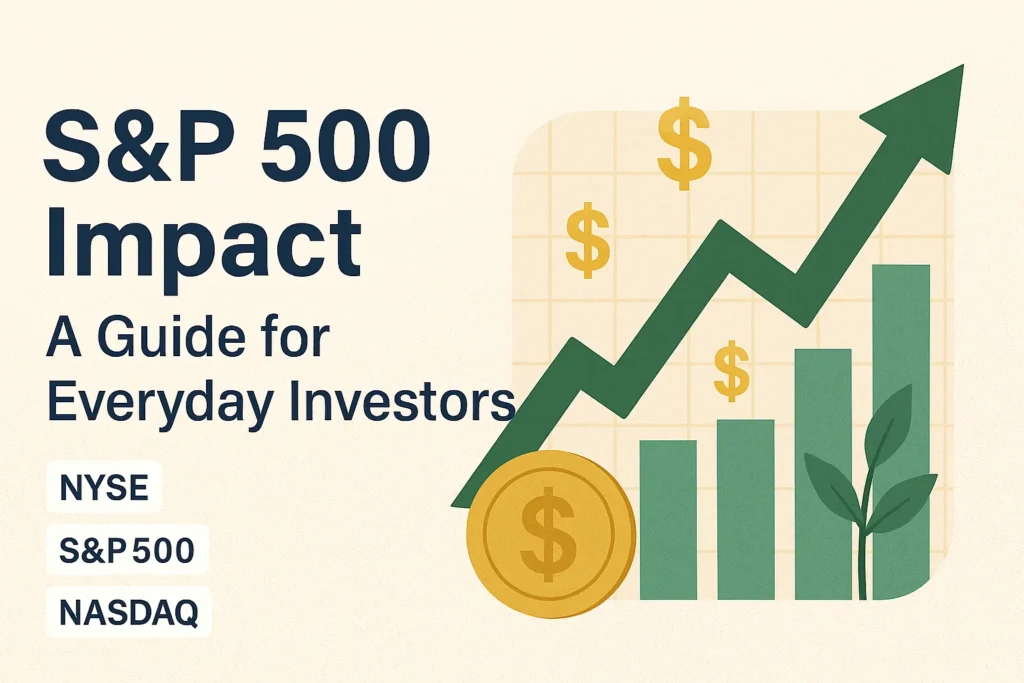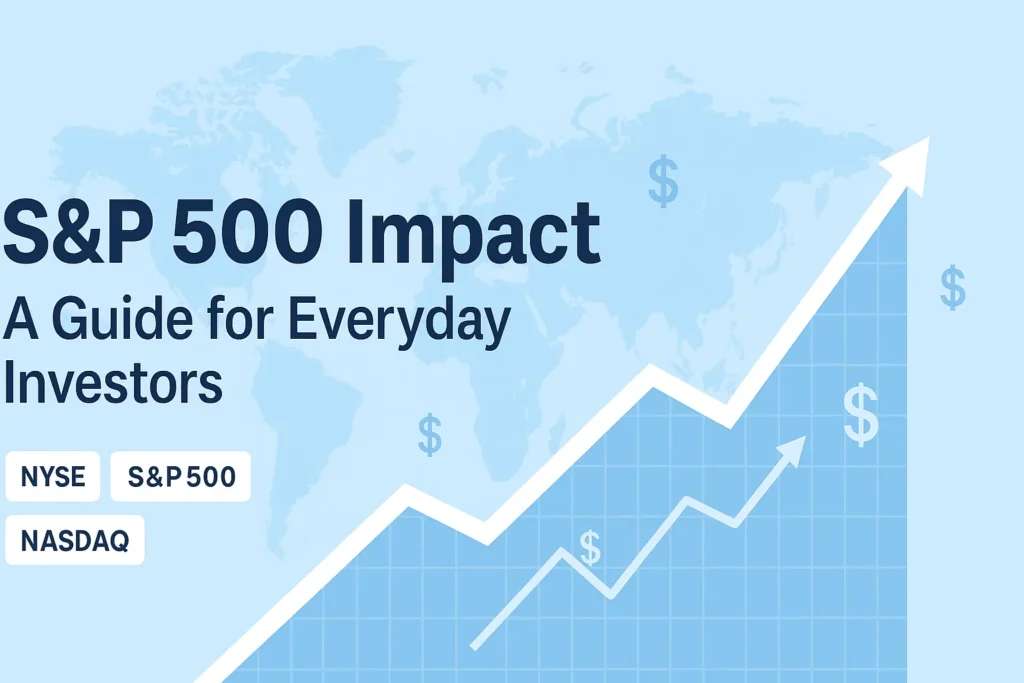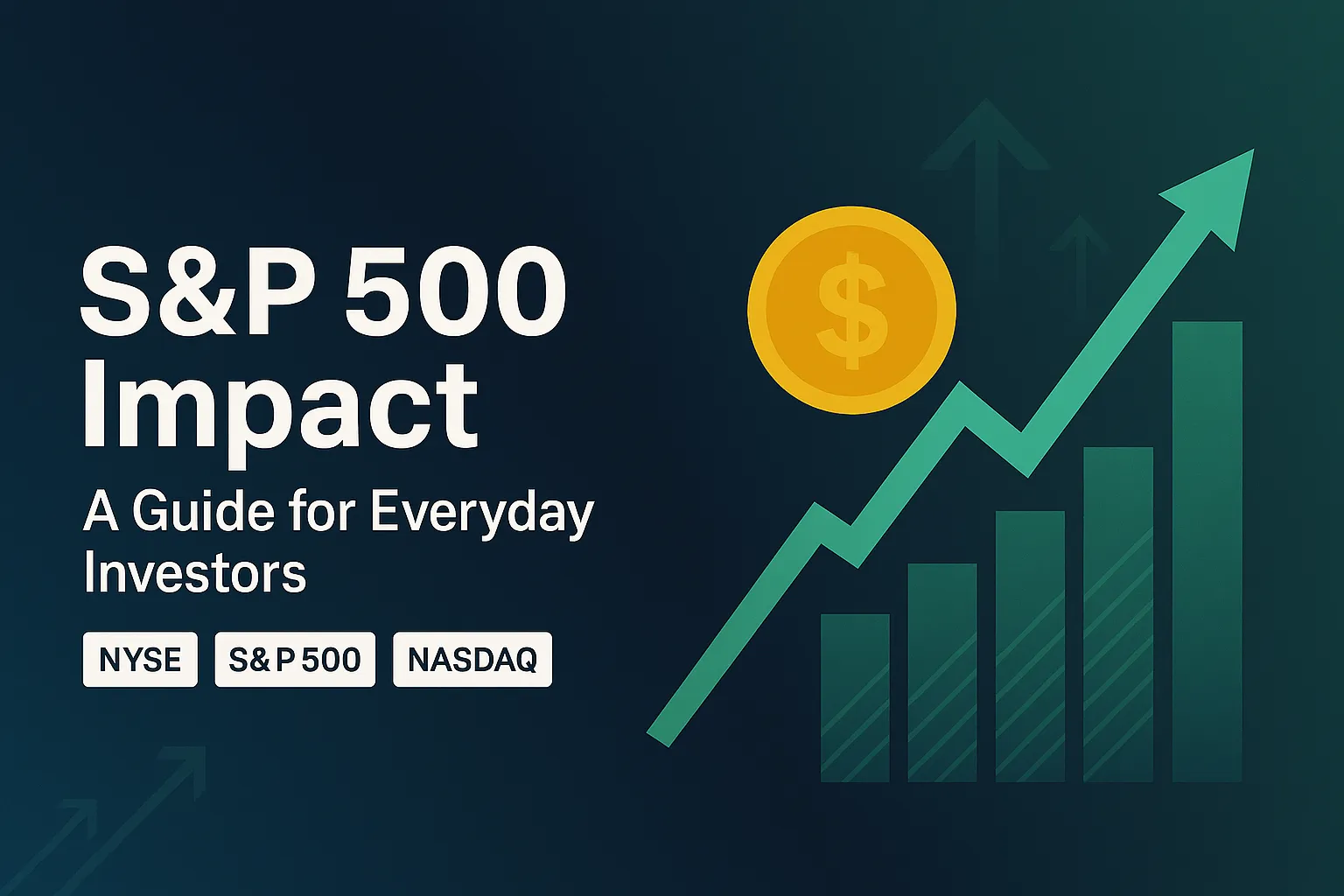Introduction:
The S&P 500 impact is a topic that resonates with both seasoned professionals and those just starting their investment journey. It’s more than just a ticker symbol flashing across financial news channels; it’s a vital indicator of market health and a key influencer of investment decisions, especially for everyday investors. Understanding the S&P 500 impact means gaining insight into the broader economy and how it can affect your portfolio, whether you’re saving for retirement, a down payment on a home, or simply growing your wealth.
Understanding the S&P 500: A Foundation for Investors

Before diving into the S&P 500 impact, it’s essential to understand what this index represents. The S&P 500, or Standard & Poor’s 500, is a stock market index that tracks the performance of 500 of the largest publicly traded companies in the United States. These companies represent a broad spectrum of industries, from technology and healthcare to finance and consumer goods. Therefore, its performance provides a comprehensive view of the US economy as a whole.
Essentially, the S&P 500 isn’t just about the stock market; it’s a reflection of economic activity, consumer confidence, and corporate performance. Changes in the index’s value can signal trends in the economy, impacting everything from employment rates and interest rates to business investments and consumer spending. This is why following the S&P 500 impact is crucial for anyone involved in the financial markets.
“To further your understanding of investing principles and strategies, consider exploring reputable books on the topic, such as those available on Amazon Link to Books on Investing and the Stock Market.”
The Direct S&P 500 Impact on Everyday Investors
The S&P 500 impact is not just for institutional investors; it directly affects everyday individuals in several ways:
Diversification
Diversifying your portfolio across different asset classes is key to mitigating the risks associated with the S&P 500 impact. Don’t put all your eggs in a single basket. Consider including assets like bonds, real estate, and international stocks to reduce your vulnerability to S&P 500 fluctuations.
Long-Term Investing
A long-term approach can help weather the storms of market cycles. Avoid getting swayed by short-term volatility, and stay focused on your long-term investment goals. For example, history shows that the S&P 500 tends to trend upwards over extended periods, making patience a valuable asset.
Staying Informed
Keep abreast of current economic news, monitor the S&P 500, and consult with financial advisors as needed to make informed investment decisions based on the S&P 500 impact.
Utilizing Index Funds and ETFs
Index funds and ETFs tracking the S&P 500 provide a low-cost, diversified way to invest in the broader market. The S&P 500 impact directly flows through these funds, making them a useful tool for everyday investors.
Regular Portfolio Reviews
Periodically review and adjust your portfolio to ensure it aligns with your risk tolerance and investment goals, especially in light of the S&P 500 impact.
“To effectively manage your finances and track your investments, including those related to the S&P 500, consider utilizing financial planning software. You can find helpful tools on the Amazon Link to Financial Planning Software. ” Financial Planning Software
Analyzing the S&P 500 Impact Through Market Cycles

The S&P 500 impact can be best understood by examining its performance within the context of market cycles, which typically include:
Bull Markets
During bull markets, the S&P 500 generally rises, reflecting positive economic outlooks and investor confidence. This is typically a good time for long-term investments. However, even in bull markets, it’s wise to be wary of market bubbles, where asset prices rise quickly and unsustainably. In the 2009–2020 bull market, for instance, the S&P 500 rose by around 300%.
Bear Markets
In bear markets, the S&P 500 declines, often signaling economic recession. This is when investors need to adjust their strategies, perhaps by reallocating to less risky assets, remaining diversified, or looking for long-term buying opportunities at lower prices. It’s during these downturns that the S&P 500 impact is most noticeable, as investors witness the declines in their portfolio values. The 2008 financial crisis, for example, saw the S&P 500 lose over 50% of its value.
Corrections
Corrections are temporary declines in the S&P 500, often viewed as healthy periods of readjustment. While they may not be as dramatic as bear markets, understanding the S&P 500 impact during these times is still crucial to gauge potential shifts in market trends and adjust accordingly.
Consolidations
Periods where the S&P 500 trades within a relatively narrow range, indicating indecision in the market. Knowing the S&P 500 impact here helps investors position themselves for the next major market move, whether up or down.
Harnessing the S&P 500 Impact: Practical Strategies for Investors
Leveraging knowledge of the S&P 500 impact can greatly enhance investment strategies:
- Diversification: Diversifying your portfolio across different asset classes is key to mitigating the risks associated with the S&P 500 impact. Don’t put all your eggs in one basket. Consider including assets like bonds, real estate, and international stocks to reduce your vulnerability to S&P 500 fluctuations.
- Long-Term Investing: A long-term approach can help weather the storms of market cycles. Avoid getting swayed by short-term volatility, and stay focused on your long-term investment goals. For example, history shows that the S&P 500 tends to trend upwards over extended periods, making patience a valuable asset.
- Staying Informed: Keep abreast of current economic news, monitor the S&P 500, and consult with financial advisors as needed to make informed investment decisions based on the S&P 500 impact.
- Utilizing Index Funds and ETFs: Index funds and ETFs tracking the S&P 500 provide a low-cost, diversified way to invest in the broader market. The S&P 500 impact directly flows through these funds, making them a useful tool for everyday investors.
- Regular Portfolio Reviews: Periodically review and adjust your portfolio to ensure it aligns with your risk tolerance and investment goals, especially in light of the S&P 500 impact.
Financial Analysis and Charting Tools:
“For investors who want to actively track and analyze the S&P 500 and other financial data, various tools are available, including those found on Amazon Link to Financial Analysis and Charting Tools.”
The Psychological S&P 500 Impact
Beyond the technicalities, the S&P 500 impact also plays a significant psychological role. Rising markets can fuel investor optimism and encourage more risky behavior, while declining markets can induce fear and lead to panic selling. Understanding your own psychological biases and remaining disciplined are crucial to making rational investment decisions, regardless of market conditions. This requires recognizing emotional biases like loss aversion (feeling the pain of losses more acutely than the pleasure of gains) and confirmation bias (seeking out information that confirms existing beliefs).
Conclusion: S&P 500 impact
The S&P 500 impact is far-reaching, affecting not just professional investors but everyday individuals managing their savings and investment portfolios. By understanding what the S&P 500 is, how it operates, and how it responds to various market cycles, investors can make more informed decisions, mitigate risks, and position themselves for long-term financial success. The S&P 500 impact is a critical element in the overall financial landscape, and its influence on your investments cannot be understated. By leveraging this knowledge and implementing sound investment strategies, you can navigate the complexities of the market and work towards achieving your financial goals.
The S&P 500 Impact: FAQs for Everyday Investors
Understanding the S&P 500 impact on everyday investors is crucial for navigating the market. Here are some frequently asked questions to shed more light on this influential index:
What is the S&P 500, and why is it important to everyday investors?
The S&P 500, or Standard & Poor’s 500, tracks the performance of 500 of the largest publicly traded companies in the United States. This index is considered a benchmark for the health of the US stock market and economy. Its importance to everyday investors includes:
- Diversification: Investing in an S&P 500 index fund or ETF offers exposure to many sectors and companies, which spreads risk.
- Performance Benchmark: This helps gauge the performance of your own investments. If your portfolio consistently underperforms the S&P 500, it may be time to reassess your strategy.
- Accessible Investment: Many mutual funds and Exchange-Traded Funds (ETFs) track the S&P 500, making it easy for individual investors to gain exposure to the market’s returns without buying 500 individual stocks.
How does the S&P 500 impact my retirement savings?
The S&P 500 impact on everyday investors extends to retirement savings, particularly if retirement accounts, like 401(k)s or IRAs, are invested in index funds that track the S&P 500. Long-term market trends, reflected in the S&P 500, can significantly influence the growth of your nest egg. Historically, the S&P 500 has provided favorable outcomes for long-term investors. However, past performance isn’t a guarantee of future returns. Market downturns, as reflected in the S&P 500, can impact account value, which highlights the importance of a long-term perspective and avoiding emotional decisions during periods of volatility.
What are the risks of investing in the S&P 500?
While the S&P 500 offers diversification, it’s not without risks:
- Market Risk: The S&P 500 is subject to the stock market’s volatility. Economic uncertainties, interest rate changes, or geopolitical events can all affect its performance.
- Concentration Risk: The index is market-cap-weighted, meaning larger companies have a greater influence. If these mega-cap stocks underperform, it can impact the entire index.
- Short-Term Declines: The S&P 500 can experience negative returns in any given year. Investors should be prepared for these potential fluctuations and focus on the long term.
Should I invest only in the S&P 500, or diversify further?
While the S&P 500 impact on everyday investors provides broad exposure to US large-cap equities, further diversification is generally wise. The index doesn’t include small-cap companies, and it’s a US-centric index, meaning it doesn’t accurately reflect the performance of global markets. A well-diversified portfolio might include:
- International Stocks: Investing in companies outside the US can provide additional growth opportunities and further reduce risk.
- Bonds: Stocks and bonds often have a negative correlation, meaning that when one is down, the other may be up. Including bonds in your portfolio can help manage overall risk.
- Real Estate or Other Assets: Further diversification into other asset classes can provide additional stability and potential returns.
How can the S&P 500 help me understand the broader economy?
The S&P 500 is often seen as a barometer of the US economy’s health because it broadly covers leading companies across various sectors. When the index is performing well, it typically indicates economic growth and positive sentiment. Conversely, a declining S&P 500 can suggest broader economic challenges or uncertainties. Analyzing the S&P 500 alongside other economic indicators, such as GDP growth, inflation rates, and employment figures, can provide a more comprehensive understanding of the overall economic landscape and the potential S&P 500 impact on everyday investors.
Affiliate & Legal Disclaimer
This article relies on internal data, publicly available information, and other reliable sources. It may also include the authors’ personal views. However, it’s essential to note that the information is for general, educational, and awareness purposes only—it doesn’t disclose every material fact. This analysis is for informational purposes only and does not constitute financial advice. Consult a professional before making investment decisions. This article contains affiliate links from Amazon and ClickBank. If you purchase through these links, we may earn a commission—at no extra cost to you.
We publish information on World Virtual CFO in good faith, solely for general information. World Virtual CFO doesn’t guarantee the completeness, reliability, or accuracy of this information. These are our views for informational purposes. When you use our website, know that any action you take is entirely at your own risk. World Virtual CFO won’t be liable for any losses or damages connected to your use of our website. For detailed information, refer to our disclaimer page.
By carefully selecting and promoting relevant affiliate products, you can potentially earn income while providing value to your readers and enhancing their understanding of the S&P 500.
Dr. Dinesh Sharma is an award-winning CFO and AI strategist with over two decades of experience in financial leadership, digital transformation, and business optimization. As the founder of multiple niche platforms—including WorldVirtualCFO.com—he empowers professionals and organizations with strategic insights, system structuring, and innovative tools for sustainable growth. His blogs and e-books blend precision with vision, making complex financial and technological concepts accessible and actionable.

3 thoughts on “S&P 500 Impact: A Guide for Everyday Investors Know Now”